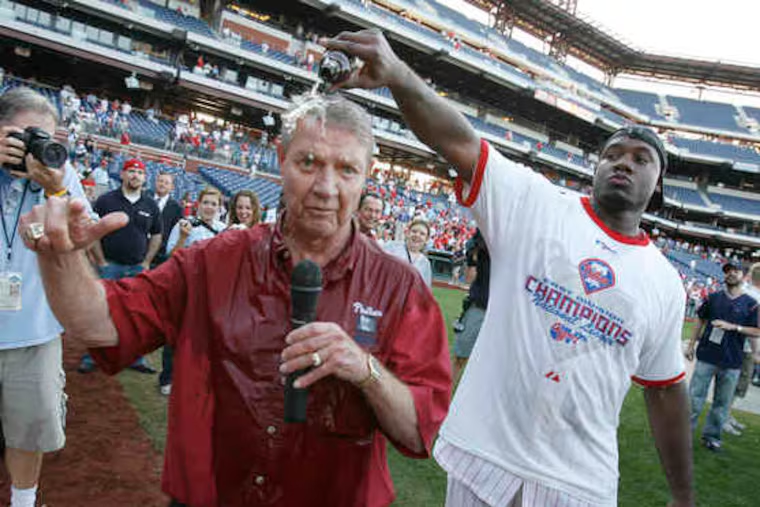The 2019 Phillies look a lot like the 2007 Phillies did at the All-Star break | Bob Brookover
Phillies fans wanted the manager fired because the team, after some notable off-season additions, underachieved before the All-Star break. That was the story of the 2007 Phillies and the 2019 team, too.

The mood could not have been more foul at the All-Star break. The fans wanted the manager fired, the former first overall pick in the draft was underachieving, and almost no one thought it would be the year that the Phillies finally ended their long playoff drought.
That was the story of the 2007 Phillies, a team that had been built to bash the baseball but many nights could not provide a lead big enough for the worst pitching staff in the National League.
The Phillies thought they had addressed some of their pitching problems in the offseason by signing Adam Eaton and trading for Freddy Garcia, but those two just poured gasoline on the starting pitching fire.
Only Charlie Manuel seemed optimistic about the second half as the players went their separate ways following a victory at Coors Field in Colorado that allowed the Phillies to even their record at 44-44 before the break.
“Once we get all our players back and get 100 percent and add a couple of pitchers, we’re going to be OK,” Manuel said at the time. “Outside that, we’ll be all right.”
You wondered if Manuel, far more beleaguered at that time than current Phillies manager Gabe Kapler is now, would have looked at San Francisco during its historic 1906 earthquake and declared that “outside the fire, everything should be OK.”
His evaluation was not shared by many.
“No, we’re not in a fortunate spot,” said shortstop Jimmy Rollins, who had declared the Phillies the team to beat before the start of the season.
“We should be better,” closer Brett Myers said. “You can't be pleased with it, but you also have to take into consideration what happened. Hopefully the break will get everybody healthy and we'll come back and dominate in the second half like we have the past couple years. Usually when people go home they get rejuvenated.”
The first-half tale of that Phillies season rarely gets told, and with good reason. It takes too long to tell the part of the story about how the 2007 team overcame a seven-game deficit to the New York Mets with 17 to play and won its first division title since 1993.
Manuel, of course, did not lose his job and instead went on to become a Philadelphia icon as well as the most successful manager in franchise history.
If there’s anything to be learned from that crazy, wonderful season, it might just be the way that general manager Pat Gillick conducted business coming out of the All-Star break.
Things got worse before they got better for the Phillies. They lost Chase Utley just before the trade deadline to a broken hand and Gillick swung a trade with the White Sox for veteran Tadahito Iguchi. The price was minor-league pitcher Michael Dubee, the son of former Phillies pitching coach Rich Dubee. Iguchi hit .301 with 10 extra-base hits during Utley’s month-long absence.
Three days later, Gillick traded minor-league pitcher Matt Maloney to the Reds for righthander Kyle Lohse. The Phillies went 9-2 in Lohse’s 11 starts that season.
Those were not earth-shattering moves, but Gillick was brilliant that season at making on-the-margin acquisitions and he stuck with that mode of operation at a time when it did not seem possible the Phillies could win the division.
During the offseason, Gillick had signed Jayson Werth as a low-profile free agent and claimed Greg Dobbs off waivers. In late June, he signed reliever J.C. Romero after he had been released by Boston. All three dirt-cheap transactions not only helped the Phillies win the division in 2007, they also helped them win a World Series a year later.
The Braves, who were in second place at the break, reeled in the grand prize of the 2007 trade deadline by getting first baseman Mark Teixeira and veteran lefty reliever Ron Mahay, but they paid a steep price, giving up four players (Elvis Andrus, Neftali Feliz, Matt Harrison and Jarrod Saltalamacchia) who could have helped them for quite some time in the future.
This is all relevant to the 2019 Phillies because like the 2007 team they have underachieved, which was the exact word Jay Bruce used to describe the 47-43 record the team will take into Friday night’s game against Washington at Citizens Bank Park.
Kapler, predictably, remained optimistic about what can happen going forward.
“Some adversity in the first half, without question,” the manager said. “But we’re in a good position to open up the second half. I think we’re all feeling pretty confident.”
We shall see what general manager Matt Klentak does in the three weeks until the July 31 trade deadline. He might be better served going for the less high-profile, lower-cost pitching additions like Andrew Cashner in Baltimore or Tanner Roark in Cincinnati than paying a steep price for San Francisco’s Madison Bumgarner or Toronto’s Marcus Stroman.
Of course, we shall also see what Bryce Harper and company can do in the second half, too. Harper, like the Phillies’ remodeled offense, was good but not great before the break. Pat Burrell was the struggling former first overall pick who struggled through the first half of the 2007 season, hitting just .215. After the break, he hit .295 with 19 home runs and 60 RBIs in 74 games. Harper is capable of doing that and even more.
Are the 2019 Phillies capable of doing what the 2007 team did? It seems unlikely.
Get insights on the Phillies delivered straight to your inbox with Extra Innings, our newsletter for Phillies fans by Matt Breen, Bob Brookover and Scott Lauber. Click here to sign up.